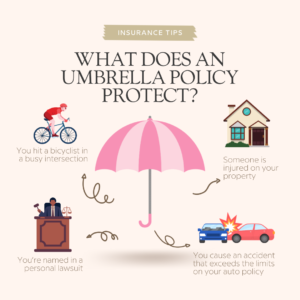Increasing the personal liability coverage limits on your auto and homeowners insurance as your income grows is a smart move. But there are limits to how much personal liability insurers will cover as a part of these asset-specific policies. That’s where an umbrella policy comes in.
This type of policy protects your current assets and your future income against financial claims for injury brought against the policyholder – and their family or household members. It isn’t a standalone policy; it provides excess coverage in addition to other existing policies, and only kicks in when the underlying policy limits are exhausted. Because of this, it can be more affordable than you think.
Umbrella policies can be flexible and can be written to include many types of coverage, which makes them uniquely useful for modern, active, online lives.

It’s Not Just About Your Existing Assets – It’s About Your Potential Litigation Risk
Umbrella policies used to be seen as necessary for only very wealthy people to protect high-value assets.
A better way to think about it ties the policy not to the assets being covered, but to the risk of the policyholder being sued.
Activities, investments, or lifestyle factors that exposes you to personal liability should be considered. These can include:
- Property ownership
- Renting out investment property
- Employing staff for household, maintenance or other functions
- Having risky entertainment features – trampolines, hot tubs, swimming pools, climbing walls, fire pits
- Large scale hospitality events
- Pet ownership
- Coaching youth sports
- Hunting, fishing, boating, skiing or other activities
- A public life – online and IRL
Yes, most of these are probably covered to some extent by existing insurance. What likely isn’t covered is the full cost of defending a lawsuit and potentially having to pay an outsize judgment or settlement. This can easily outstrip current assets and put future income at risk. Umbrella policies can also be written to cover risks that aren’t covered by any other policy. In that case, the umbrella policy would have a deductible like a regular insurance policy.
What Do Umbrella Policies Cover?
There are three broad areas of coverage.
- Bodily injury to others caused by a car, boat or pet or to guest in your home due to an accident.
- Property damage, claims related to the damage, and damage caused to a school by your child.
- Injurious actions directed towards others, including slander, libel, false arrest, malicious prosecution, mental anguish or shock.
The first two are pretty straightforward, but it’s the last one that has increasingly more value in our modern lives. People have been successfully sued for leaving negative online reviews.
A policy that provides high levels of coverage can be an effective risk management tool – and can provide a lot of peace of mind.
How Much Coverage Do You Need?
Start with assessing both your current assets and the financial costs of your future goals. These may include children’s education, potentially more education for yourself, starting your own business, or investing in a hobby or building a collection of art or other objects that have meaning for you.
Employer-sponsored retirement assets are shielded from civil lawsuits, as are up to $1 million in IRA accounts, so you don’t need to consider them. If your state has a homestead law that protects a primary residence from civil judgements, your home may also be shielded.
How Expensive Is It?
Because the umbrella policy is designed to provide coverage only after other coverage is exhausted, and the likelihood of that being necessary is generally lower, the coverage is probably not as expensive as you think. A $1 million policy can typically cost between $150 and $300 per year, and for each additional $1 million in coverage the incremental costs declines.
You can sometimes save money by having the same insurer underwrite your homeowners, auto and boat policies as well as the umbrella policy. This can also simplify ensuring that your expiration dates all line up, and that you maintain the coverage on your regular insurance up to the point where the umbrella coverage begins. For example, if you change your auto insurance provider and the new policy lowers your coverage limits from $250, 000 to $100,000, you may inadvertently create a gap in coverage.
The Bottom Line
Umbrella coverage can be a useful tool to keep your financial risk management plan in line with your growing assets and an evolving lifestyle. It can provide peace of mind and allow you to get on with doing the things you enjoy, without worry. Reviewing your insurance coverage to keep it up-do-date should be part of the annual review you undertake for your entire financial plan, and making sure that you have the right types and levels of coverage is best done with an eye to your entire financial picture.
